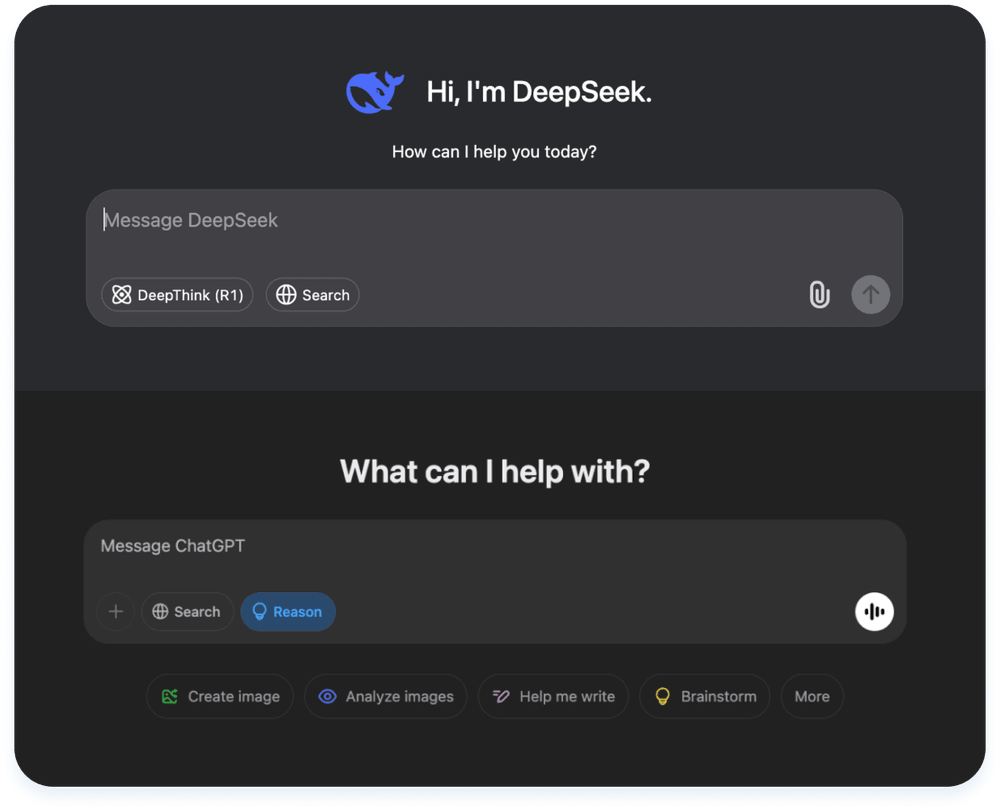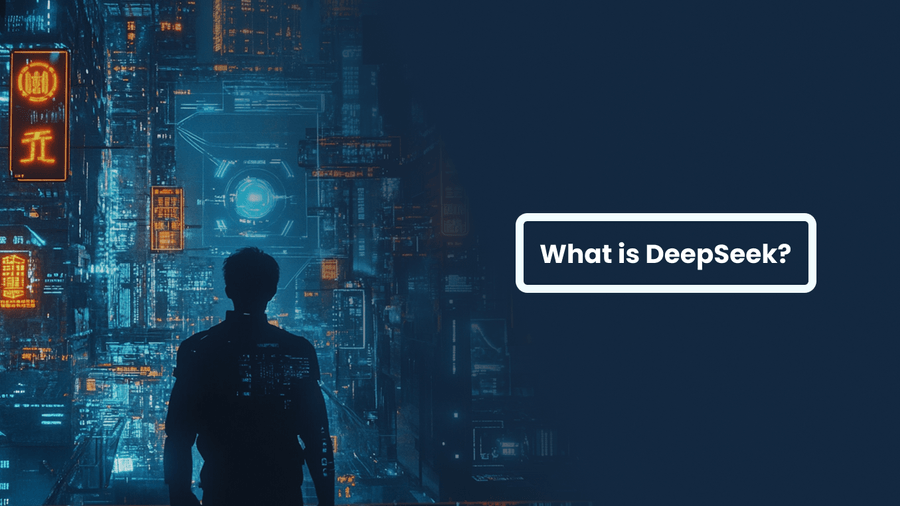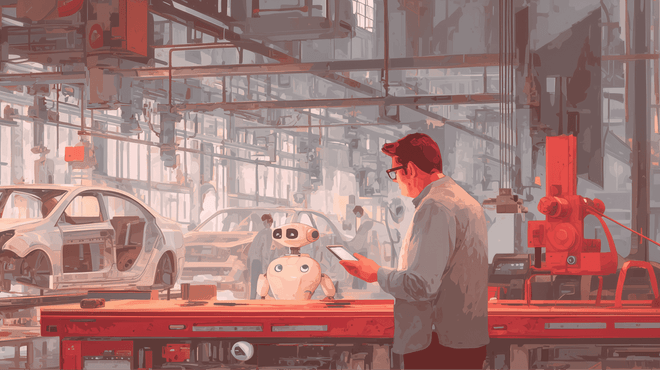Has the AI world just had its Sputnik moment? A new player has entered the scene and claimed its place under the sun once reserved for OpenAI. Yes, we’re talking about DeepSeek – a one-year-old startup from China.
In just a couple of weeks, it has sparked global attention with a series of dramatic headlines, ranging from overtaking ChatGPT on the App Store to facing bans over security concerns.
The level of buzz around DeepSeek hasn’t been seen since the ChatGPT release. But is DeepSeek truly a game-changer, or just another overhyped experiment?
In this article, we’ll break down what’s behind this technology, how it differs from ChatGPT, and what its future might look like.
Before we talk about the storm, let’s understand the wind
To understand why DeepSeek is making waves, it helps to first grasp the basics of AI. If you need a refresher, check out our article on AI fundamentals and generative AI.
In simple terms, AI learns by analyzing massive amounts of data, recognizing patterns, and solving problems. In the result we have software that can chat like a human, predict music preferences, or even generate realistic images.
Over the past few years, this technology has become best known for powering chatbots like ChatGPT — and now, DeepSeek.
These programs don’t just respond to questions; they create new content based on the vast amount of text and images they’ve been trained on.
But, as with any AI, their knowledge isn’t absolute. They don’t “know” facts the way people do. Instead, they predict the most likely answer based on patterns in data. That’s why AI responses can sometimes be misleading, biased, or just plain wrong.
DeepSeek is the name of a free AI-powered chatbot that looks, feels, and functions much like ChatGPT. Which means it can be used for the same tasks: answering questions, generating texts, writing code, summarizing articles, etc.

So, what’s DeepSeek, and why is everyone talking about it?
DeepSeek hasn’t been around for long. The company was founded in July 2023 and released its first model – DeepSeek Coder – in November of the same year. Till now several other models were released, but their presence was subtle, almost unnoticed.
That changed on January 20, 2025. DeepSeek launched its first free chatbot app for iOS and Android, powered by DeepSeek-R1, an open-weight large language model trained on a mix of publicly available and licensed data.
Unlike most competitors, DeepSeek embraced an open-source approach – handing developers and researchers a powerful tool with no locked doors.
But open source isn’t the only reason DeepSeek is making headlines. The real shockwave is its price tag.
DeepSeek’s creators claim they trained the model for just $6 million – a fraction of the “over $100 million” OpenAI’s Sam Altman hinted at for GPT-4. Some estimates put the cost even lower, at $5.6 million, which is nearly ten times cheaper than Meta’s Llama.
This raises a provocative question: is the massive funding flooding the AI market, especially in the US, really necessary?
Investors seemed to take note. When DeepSeek’s cost-efficiency became public, shares in Nvidia – the semiconductor giant powering much of the AI industry – took a sharp dive. Why?
Because if AI models can be built for less, the demand for expensive hardware might shrink.
And there’s another side to this. If AI can be trained faster and cheaper, it also means less energy consumption.
Today, AI’s hunger for electricity is driving up carbon emissions, making sustainability a growing concern. DeepSeek’s approach suggests a more sustainable path: shorter training times, lower energy consumption, and a smaller carbon footprint.
All this sets a new benchmark for AI development. Indeed.
DeepSeek vs. ChatGPT
We’ve already covered the two biggest distinctions – DeepSeek is open-source and comes with a much smaller price tag. But at first glance, the experience of using both models feels nearly identical. Open the chat, type a question, get an answer. The interface looks familiar, and the core functionality is the same.

Yet, some users have noticed a shift in how DeepSeek handles certain tasks. It seems to excel in reasoning-heavy problems like coding, math, and structured problem-solving. Instead of offering a conversational flow like ChatGPT, it often delivers precise, straight-to-the-point responses.
AI researcher Javier Aguirre, who works at Samsung Medical Center in Seoul, shared his own experience:
He also pointed out that for developers, combining different models can lead to the best results – ChatGPT for a broader approach, DeepSeek for laser-focused problem-solving.
But ChatGPT still holds some advantages. DeepSeek, for now, doesn’t support images – it lacks features like custom AI behavior tuning, voice interaction, and text-to-image generation.
And then there’s the censorship debate. Some users have reported that DeepSeek is stricter on sensitive topics like politics and global affairs. While OpenAI models often attempt to engage in a discussion before refusing a response, DeepSeek tends to shut down certain queries immediately.

Growing – and familiar – security concerns
However, there’s a storm cloud over DeepSeek’s success: security.
Western skepticism toward Chinese technology is as old as the Great Wall itself. The vivid examples are TikTok, which has faced repeated bans and restrictions over data privacy fears, or Huawei, which was locked out of 5G networks in multiple countries over concerns about potential state influence.
Australia has already banned DeepSeek from government devices and systems, citing national security risks. Italy blocked the app in late January, ordering the company to stop processing its citizens’ personal data.
Meanwhile, data protection authorities worldwide are pressing DeepSeek for clarity on how it handles user information, which is stored on servers based in China.
Are the concerns justified? DeepSeek’s open-source nature and reliance on Chinese servers really raise red flags. Critics argue that data stored in China could be subject to local laws requiring access by authorities, which creates potential vulnerabilities.
Security is a foundation of your AI success
Learn how to protect your data in our AI security whitepaper.
The future of DeepSeek and AI
Still, it’s too early to jump to conclusions. The AI race moves at breakneck speed, and both OpenAI and DeepSeek are undoubtedly preparing their next big steps.
DeepSeek’s rapid rise has already proven one thing: the dominance of Western AI labs isn’t as unshakable as it once seemed. For all the billions poured into AI development by US firms, a Chinese startup has shown that cutting-edge models can be built with far fewer resources.
This challenges the long-held belief that only the biggest players with the deepest pockets can push AI forward.
What happens next? OpenAI is expected to release GPT-5 sometime in 2025, and it wouldn’t be surprising if it raises the bar once again. Meanwhile, DeepSeek is unlikely to stop at its current achievements.
Will it push further into open-source AI? Will it expand beyond text-based models? Or will new competitors emerge to shake up the field even more?
One thing is clear: the AI world isn’t standing still, and the battle for the next breakthrough is just getting started.
The AI race is on – are you keeping up?
Innovation waits for no one. Our team can help build, scale, or optimize AI.




